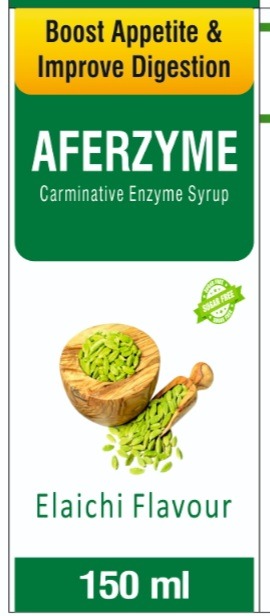Boost Appetite & Improve Digestion


AFERZYME
Carminative Enzyme Syrup
Sugar Free
Chitrak (Plumbago): Chitrak, also known as Plumbago zeylanica or Plumbago indica, is a perennial herb that is native to South Asia. Its roots and rhizomes are commonly used in Ayurvedic medicine and traditional Chinese medicine to treat various ailments, such as digestive disorders, respiratory infections, fever, and skin diseases. Chitrak is also known for its anti-inflammatory, analgesic, and antimicrobial properties. However, it should be used under medical supervision as it can have side effects and interact with other medications.
Jeerak (Cuminum Cyminum): They are commonly used in curries, soups, stews, and other dishes to add flavor and aroma. Cumin seeds are also known for their digestive properties and are often used as a home remedy for digestive issues like bloating, gas, and constipation. They are a rich source of iron, magnesium, and other essential nutrients and are considered to be a healthy addition to a balanced diet.
Sounth (Zingiber Officinale): South or ginger is known for its health benefits. It has anti-inflammatory properties and is used to treat various ailments such as nausea, vomiting, indigestion, and sore throat. Ginger is also used in many forms such as fresh, dried, powdered, and as a juice or oil.
Chavya (Piper Retrofractum): The fruit of the Chavya plant is used in Ayurvedic medicine to treat various ailments such as digestive issues, respiratory disorders, joint pain, and skin diseases. It is believed to have anti-inflammatory, analgesic, and digestive properties. Chavya is often used as a digestive stimulant and is known to enhance the secretion of digestive juices, promoting healthy digestion.
Saunf (Foeniculum Vulgare): Saunf or fennel seeds are commonly used as a mouth freshener and have digestive and anti-inflammatory properties. In traditional Ayurvedic medicine, Saunf is believed to have several medicinal properties. It is often used as a digestive aid and is known to help alleviate digestive issues such as bloating, flatulence, and indigestion. Saunf has carminative properties that help to relax the intestinal muscles and relieve gas and bloating. Saunf is also used for its antispasmodic and anti-inflammatory properties. It is often used to relieve menstrual cramps and to ease the symptoms of menopause. Saunf has estrogen-like compounds that help to regulate the hormonal balance in women and reduce the severity of menstrual cramps.
Bhringraj (Eclipta Alba): Bhringraj is also used for its liver-protective properties. It promotes liver health and protects it from various toxins and chemicals. Bhringraj is also used to treat digestive issues such as constipation, bloating, and indigestion. It improves digestion by promoting the secretion of digestive juices and enzymes. Bhringraj is also used for its anti-inflammatory and analgesic properties. It reduces inflammation and pain in various parts of the body. Bhringraj is also used to treat skin diseases such as eczema, psoriasis, and dermatitis.
Amla (Emblica officinalis): Amla is known for its high content of vitamin C, which has numerous health benefits. It is often used as a natural immunity booster to improve overall health and well-being. Amla also has anti-aging properties and is often used in Ayurvedic skincare products to improve skin health and reduce signs of aging.
Amla is also used for its digestive and detoxifying properties. It promotes healthy digestion, relieves constipation, and reduces inflammation in the digestive tract. Amla is also used to purify the blood and eliminate toxins from the body.
Amla is also used for its anti-inflammatory and analgesic properties. It reduces inflammation and pain in various parts of the body. Amla is also used to treat respiratory issues such as asthma and bronchitis.
Harad (Terminalia Chebula): Harad is known for its astringent and laxative properties. It is often used to treat digestive issues such as constipation, bloating, and indigestion. It improves digestion by promoting the secretion of digestive juices and enzymes. It is also used to treat stomach ulcers and other gastrointestinal problems. Harad is also used for its anti-aging properties.
It has antioxidant properties that protect the body from damage caused by free radicals. Harad is also used to improve skin health and reduce signs of aging.
Bahera (Terminalia Bellrica): Bahera is known for its laxative and astringent properties. It is often used to treat digestive issues such as constipation, bloating, and indigestion. It improves digestion by promoting the secretion of digestive juices and enzymes. It is also used to treat stomach ulcers and other gastrointestinal problems. Bahera is also used for its anti-inflammatory and analgesic properties.
It also reduces inflammation and pain in various parts of the body. Bahera is also used to treat respiratory issues such as asthma and bronchitis.
Ajwain (Trachyspermum Ammi): Ajwain has many medicinal properties and has been used in traditional Ayurvedic medicine for centuries. It has digestive, carminative, and antispasmodic properties. It is often used to treat digestive issues such as flatulence, bloating, and indigestion. Ajwain is also beneficial for the treatment of respiratory disorders such as asthma, cough, and bronchitis.
Ajwain is rich in thymol, which is a potent antioxidant and has antimicrobial properties. It has the ability to fight against harmful bacteria, fungi, and viruses, and is often used in the treatment of infections.
Trivrit (Operculina Turpethum): Trivrit is known for its laxative properties and is often used to treat constipation and other digestive issues. It stimulates bowel movements and improves digestion by promoting the secretion of digestive juices and enzymes.
Trivrit is also used for its anti-inflammatory properties. It reduces inflammation in various parts of the body and is often used to treat conditions such as arthritis and gout.
In addition, Trivrit has antipyretic properties, which means that it can help to reduce fever. It is also used to treat respiratory issues such as asthma and bronchitis.
Vidanga (Embelia Ribes): Vidanga is known for its anthelmintic properties, which means that it can help to expel parasitic worms from the body. It is often used to treat intestinal worm infestations such as tapeworm, hookworm, and roundworm.
In addition, Vidanga have antibacterial and antifungal properties. It is used to treat various bacterial and fungal infections, such as skin infections, urinary tract infections, and respiratory infections.
Vidanga is also used to treat digestive issues such as constipation, indigestion, and flatulence. It also stimulates the digestive system and promotes the secretion of digestive juices and enzymes.
However, it is important to note that Vidanga can have some adverse effects if not used properly. Overdose or prolonged use of Vidanga can lead to side effects such as nausea, vomiting, and diarrhea. It is important to use Vidanga under the guidance of a qualified healthcare professional.
Lavang (Syzygium Aromaticum): Lavang is known for its many health benefits. It is rich in antioxidants, which help to protect the body against damage from free radicals. It also has anti-inflammatory properties, which make it useful for reducing inflammation and pain in various parts of the body.
Lavang is often used to treat digestive issues such as bloating, gas, and indigestion. It promotes the secretion of digestive juices and enzymes, which can improve digestion and reduce digestive discomfort.
Lavang is also used to treat respiratory issues such as coughs and asthma. It has expectorant properties, which means that it can help to loosen phlegm and mucus in the respiratory tract, making it easier to cough up.
In addition, Lavang is used in traditional Ayurvedic medicine for its analgesic and antiseptic properties. It is often used to treat toothaches and other types of pain, as well as to disinfect wounds and prevent infections.
Mug Pipal (Piper Longum): Mug Pipal, also known as Piper Longum or Indian Long Pepper, is a flowering vine that is native to India, Nepal, and Sri Lanka. It has been used in Ayurvedic medicine for thousands of years due to its many health benefits.
Mug Pipal is known for its digestive and respiratory benefits. It is believed to stimulate digestion and increase appetite. It is also used to treat respiratory issues such as coughs, colds, and asthma. It is believed to have expectorant properties, which help to loosen phlegm and mucus in the respiratory tract, making it easier to cough up.
Mug Pipal is also used for its analgesic and anti-inflammatory properties. It is often used to treat joint pain, arthritis, and other types of pain. It is also believed to have anti-inflammatory effects, which make it useful for reducing inflammation and swelling in various parts of the body.
In addition, Mug Pipal is used to improve brain function and memory. It is believed to have nootropic properties, which means that it can improve cognitive function and enhance memory and learning.
Mug Pipal is used in various Ayurvedic remedies and formulations, such as Trikatu, which is a herbal powder that is used to improve digestion, reduce inflammation, and enhance cognitive function.
However, it is important to note that Mug Pipal can have some adverse effects if not used properly. Overdose or prolonged use of Mug Pipal can lead to side effects such as nausea, vomiting, and diarrhea. It is important to use Mug Pipal under the guidance of a qualified healthcare professional.
Senna (Cassia Angustifolia): Senna, also known as Cassia Angustifolia, is a plant that is native to the Middle East and India. It has been used for centuries as a natural laxative due to its high content of anthraquinones, which are compounds that stimulate the muscles of the intestines and promote bowel movements.
In addition to its laxative effects, Senna is also believed to have anti-inflammatory, analgesic, and anti-tumor properties. It has been used in traditional medicine to treat various conditions such as skin disorders, fever, and liver diseases.
Elaichi (Elettaria Cardamomum): Elaichi or cardamom is a popular spice used in Indian cuisine and has digestive and anti-inflammatory properties.
In addition to its culinary uses, elaichi has also been used for medicinal purposes. It has antioxidant properties and helps with digestive issues such as bloating and stomach cramps. It has also been used as a natural breath freshener and may help to reduce bad breath.
Rasna (Pluchea Lanceolata): Rasna has been used for centuries in Ayurvedic medicine to treat various ailments. It has anti-inflammatory, analgesic, and antipyretic properties, making it useful in the treatment of conditions such as arthritis, fever, and pain.
The plant contains a variety of bioactive compounds, including flavonoids, terpenoids, and phenolic acids, which are thought to be responsible for its medicinal properties. These compounds have been shown to have antioxidant and anti-inflammatory effects in the body.
In addition to its traditional uses, Rasna has also been studied for its potential to treat other conditions, such as diabetes, asthma, and skin diseases.
Kala Namak (Unaqua Sodium Chloride): Kala Namak is made by heating natural salt deposits with charcoal, herbs, seeds, and other spices in a furnace until it is heated to a high temperature. This process gives the salt its distinctive color and aroma. The salt is then cooled and ground into a fine powder.
In addition to its culinary uses, Kala Namak is also used in Ayurvedic medicine as a digestive aid and to treat conditions such as bloating and constipation. It is also believed to have anti-flatulent and anti-inflammatory properties.
However, it is important to note that Kala Namak, like all forms of salt, should be consumed in moderation as excessive consumption can lead to health issues such as high blood pressure and heart disease.
Sendha Namak (Sodium Chloride): Sendha Namak is used as Ayurvedic medicine. It has anti-inflammatory and alkalizing properties and may help to balance the body's pH levels. It is also thought to aid in digestion and improve skin health.
While Sendha Namak is a natural salt and may contain some trace minerals, it should still be consumed in moderation like any other type of salt. Excessive salt consumption can lead to health problems such as high blood pressure and heart disease.
It is used to treat Digestive issues such as Constipation, Flatulence, Bloating, and Indigestion. It has Digestive, Laxative, Carminative, Anthelmintic and Antispasmodic properties. It improves Digestion by promoting the secretion of Digestive Juices and Enzymes.
